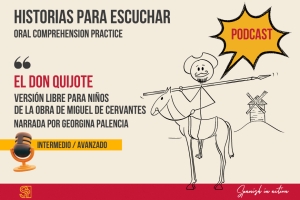This dress fits me yes or no! I don’t understand you.
In Spanish, as in many other languages, intonation has different values that make it possible to understand or not the idea of what we want to transmit.
In this blog I am going to share with you a very old exercise of Spanish teachers as a mother tongue, but which is also very useful for students of Spanish as a foreign language.
But first, let’s look at some distinctive aspects of Spanish intonation. As the crow flies, because this is just practice. By the way, bird flight, is a very popular expression to say that it will be explained quickly and superficially.
Spanish intonation:
• The tone distinguishes discursive meanings. Depending on if it is an affirmation, if it is a question, a command…
• There are basically three types of tones:
–descending, for the affirmative sentence, although if it has more than one phonic group (more than one group of words said with a single breath) it will be like a ball rebound that first hits the ground, rises to a peak and descends again;
– ascending, for the question;
–horizontal, for exclamatory and imperative sentences.
• The tone pattern is by functions of the sentence (a type of sentence it is) or parts of the sentence (where we want to emphasize) and not by structures, because the structure of the sentence in Spanish is flexible.
• Only intonation gives function to the sentence. In English, for example, questions usually start with an auxiliary verb, and because of that it is identified. In Spanish, this function is given only by intonation.
• Each type of function can also have intonating varieties. For example, the total question is ascending. Did you buy the cake for the party? But if it is partial, it can also be descending. Who rang the bell?
• The pause (governed by oral or written fluency) determines the tonal registers since they are different in types and have different functions.
In Spanish, intonation is important for understanding.
It is not the same to say this dress fits me well with ascending intonation and wait for an answer, or with a descending intonation and wait for an empathetic smile.
Does this dress fit me well? or This dress fits me well.
So, it is worth exercising the intonation a bit, deliberately, with a lot of emphasis.
Within this short time, I will try to show you. By an unknown author, you will see the same text, said differently, has a totally different meaning.
The activity consists of reading a text that, respecting the proposed punctuation marks, has a meaning, but if we alter the intonation, in this case because it is written, altering the punctuation first, it may have other meanings.
It is also an excellent opportunity for us to link body expression to intonation. For Spanish speakers, this relationship between gesture and word is also native. Furthermore, the more emphatic we are with the gesture, the more clarity the meaning of our ideas, made into sentences, will have.
This is the order of the instructions:
- Read the proposed love story.
- I am going to give you the text without punctuation.
- You are going to write three versions with punctuation (the interpretation made by each character in the story).
- Then you are going to read each interpretation aloud and share it with someone who confirms if in the version you have read, the loved one is the one you believe.
- I will also give you the versions with the punctuation of each one, that is, the results. But make your attempt, do not go directly to the resolution.
Story: Three young sisters fell in love with a handsome man they had met. He visited them frequently. They asked him to let them know which of the three he loved. The young man sent them a letter saying this …

(Three beautiful that are beautiful have demanded me the three to tell which is the one that my heart loves if obeying is a reason I say that I love Soledad, not Julia whose kindness human person does not have does not aspire my love to Irene that is not little her goodness)
Remember to read your own version of each lady aloud to your teacher, classmate, Spanish-speaking friend.
If you don’t emphasize the tones enough, we will still not know who the young man loves, and we will contribute to the battle between women. No. We cannot allow ourselves to witness the deceit of any man or woman. Let’s talk better to build a better world.
Answers:




